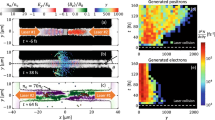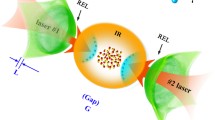Abstract
Irradiating high-Z targets such as gold with ultra-intense lasers creates electron-positron pairs. In particular, the positron density in the plasma created by this procedure is higher than that obtained via other laboratory-based methods, with theoretical maximum densities exceeding 1018 cm−3. All of the significantly contributing processes are well-known and hence we can study this phenomenon using Monte Carlo simulation. We focus on the latter part of this procedure, the passage of high-energy electrons through the target creating pairs. In particular, we discuss the usefulness of CERN’s GEANT4 Monte Carlo code in simulating this process. Once this code is successfully calibrated, we will use it to perform parameter studies, and design future targets to optimize the positron yield.
Similar content being viewed by others
References
Chen, H.: Private communication (2011)
Chen, H., et al.: Relativistic positron creation using ultraintense short pulse lasers. Phys. Rev. Lett. 102, 105001 (2009)
GEANT4: http://geant4.web.cern.ch/geant4/support/download.shtml (2010a). Retrieved 11 January 2011
GEANT4: http://geant4.web.cern.ch/geant4/UserDocumentation/UsersGuides/PhysicsReferenceManual/fo/PhysicsReferenceManual.pdf (2010b). Retrieved 11 January 2011
Liang, E.P.: High Energy Density Physics (2010, to appear)
Liang, E.P., Dermer, C.: Electron thermalization and heating in relativistic plasmas. Astrophys. J. Lett. 325, L39 (1988)
Meszaros, P.: Theories of gamma-ray bursts. Annu. Rev. Astron. Astrophys. 40, 137 (2002)
Nakashima, K., Takabe, H.: Numerical study of pair production by ultraintense lasers. Phys. Plasmas 9, 1505 (2002)
Wardle, J., et al.: Electron-positron jets associated with the quasar 3C279. Nature (London) 395, 457 (1998)
Author information
Authors and Affiliations
Corresponding author
Rights and permissions
About this article
Cite this article
Henderson, A., Liang, E., Yepes, P. et al. Monte Carlo simulation of pair creation using petawatt lasers. Astrophys Space Sci 336, 273–277 (2011). https://doi.org/10.1007/s10509-011-0678-x
Received:
Accepted:
Published:
Issue Date:
DOI: https://doi.org/10.1007/s10509-011-0678-x




